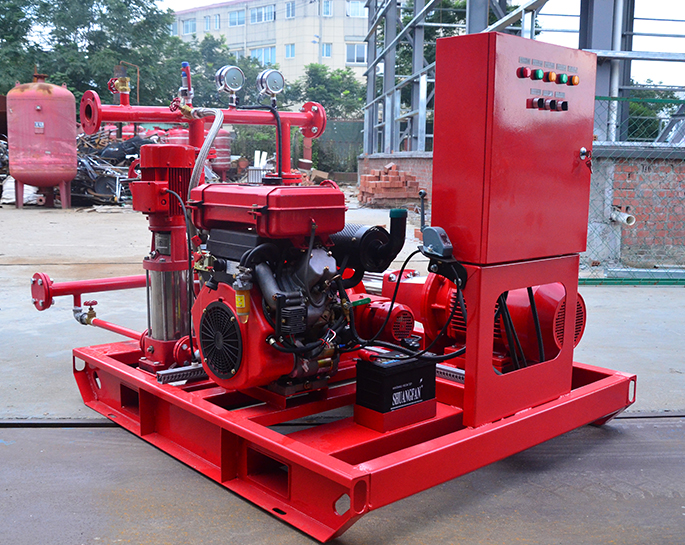What are the considerations for selecting the appropriate fire pump testing equipment and procedures?
Apr 03, 2024
Share:
Selecting the appropriate fire pump testing equipment and procedures is crucial to ensure the reliable performance of fire pump systems in emergency situations. Here are some considerations to keep in mind:
1. Compliance with Standards: Ensure that the testing equipment and procedures comply with relevant standards and regulations, such as NFPA 25 (Standard for the Inspection, Testing, and Maintenance of Water-Based Fire Protection Systems) and local fire codes.
2. Equipment Accuracy and Calibration: Choose testing equipment that is accurate, reliable, and properly calibrated to provide precise measurements of pump performance parameters, such as flow rate, pressure, and power consumption.
3. Compatibility with Pump Type: Select testing equipment that is compatible with the type and capacity of the fire pump being tested, whether it's a centrifugal pump, vertical turbine pump, or other types.
4. Safety Features: Prioritize safety by using testing equipment with built-in safety features, such as pressure relief valves, overpressure protection, and automatic shutoff mechanisms to prevent equipment damage or personal injury during testing.
5. Accessibility and Ease of Use: Opt for testing equipment that is easy to set up, operate, and maintain, and ensure that it can be easily accessed and maneuvered to perform tests on different components of the fire pump system.
6. Data Logging and Reporting: Choose testing equipment that can log test data accurately and generate comprehensive reports documenting test results, including any deviations from expected performance parameters.
7. Training and Certification Requirements: Ensure that personnel conducting fire pump tests are properly trained and certified to use the testing equipment and follow established testing procedures to maintain compliance with regulatory requirements.
8. Frequency and Schedule: Develop a testing schedule based on manufacturer recommendations, regulatory requirements, and industry best practices to ensure that fire pumps are tested regularly and reliably.
9. Integration with Maintenance Procedures: Integrate fire pump testing procedures with routine maintenance activities to streamline testing processes and minimize downtime for the fire protection system.
10. Documentation and Record Keeping: Maintain accurate records of all fire pump tests, including test dates, procedures, results, any corrective actions taken, and personnel involved, to demonstrate compliance with regulatory requirements and facilitate troubleshooting and analysis of pump performance over time.
By considering these factors, you can select the appropriate fire pump testing equipment and procedures to ensure the reliable performance of fire pump systems and compliance with regulatory requirements. Regular testing and maintenance are essential for safeguarding life and property from fire hazards.

1. Compliance with Standards: Ensure that the testing equipment and procedures comply with relevant standards and regulations, such as NFPA 25 (Standard for the Inspection, Testing, and Maintenance of Water-Based Fire Protection Systems) and local fire codes.
2. Equipment Accuracy and Calibration: Choose testing equipment that is accurate, reliable, and properly calibrated to provide precise measurements of pump performance parameters, such as flow rate, pressure, and power consumption.
3. Compatibility with Pump Type: Select testing equipment that is compatible with the type and capacity of the fire pump being tested, whether it's a centrifugal pump, vertical turbine pump, or other types.
4. Safety Features: Prioritize safety by using testing equipment with built-in safety features, such as pressure relief valves, overpressure protection, and automatic shutoff mechanisms to prevent equipment damage or personal injury during testing.
5. Accessibility and Ease of Use: Opt for testing equipment that is easy to set up, operate, and maintain, and ensure that it can be easily accessed and maneuvered to perform tests on different components of the fire pump system.
6. Data Logging and Reporting: Choose testing equipment that can log test data accurately and generate comprehensive reports documenting test results, including any deviations from expected performance parameters.
7. Training and Certification Requirements: Ensure that personnel conducting fire pump tests are properly trained and certified to use the testing equipment and follow established testing procedures to maintain compliance with regulatory requirements.
8. Frequency and Schedule: Develop a testing schedule based on manufacturer recommendations, regulatory requirements, and industry best practices to ensure that fire pumps are tested regularly and reliably.
9. Integration with Maintenance Procedures: Integrate fire pump testing procedures with routine maintenance activities to streamline testing processes and minimize downtime for the fire protection system.
10. Documentation and Record Keeping: Maintain accurate records of all fire pump tests, including test dates, procedures, results, any corrective actions taken, and personnel involved, to demonstrate compliance with regulatory requirements and facilitate troubleshooting and analysis of pump performance over time.
By considering these factors, you can select the appropriate fire pump testing equipment and procedures to ensure the reliable performance of fire pump systems and compliance with regulatory requirements. Regular testing and maintenance are essential for safeguarding life and property from fire hazards.


.png)
.png)

.png)


